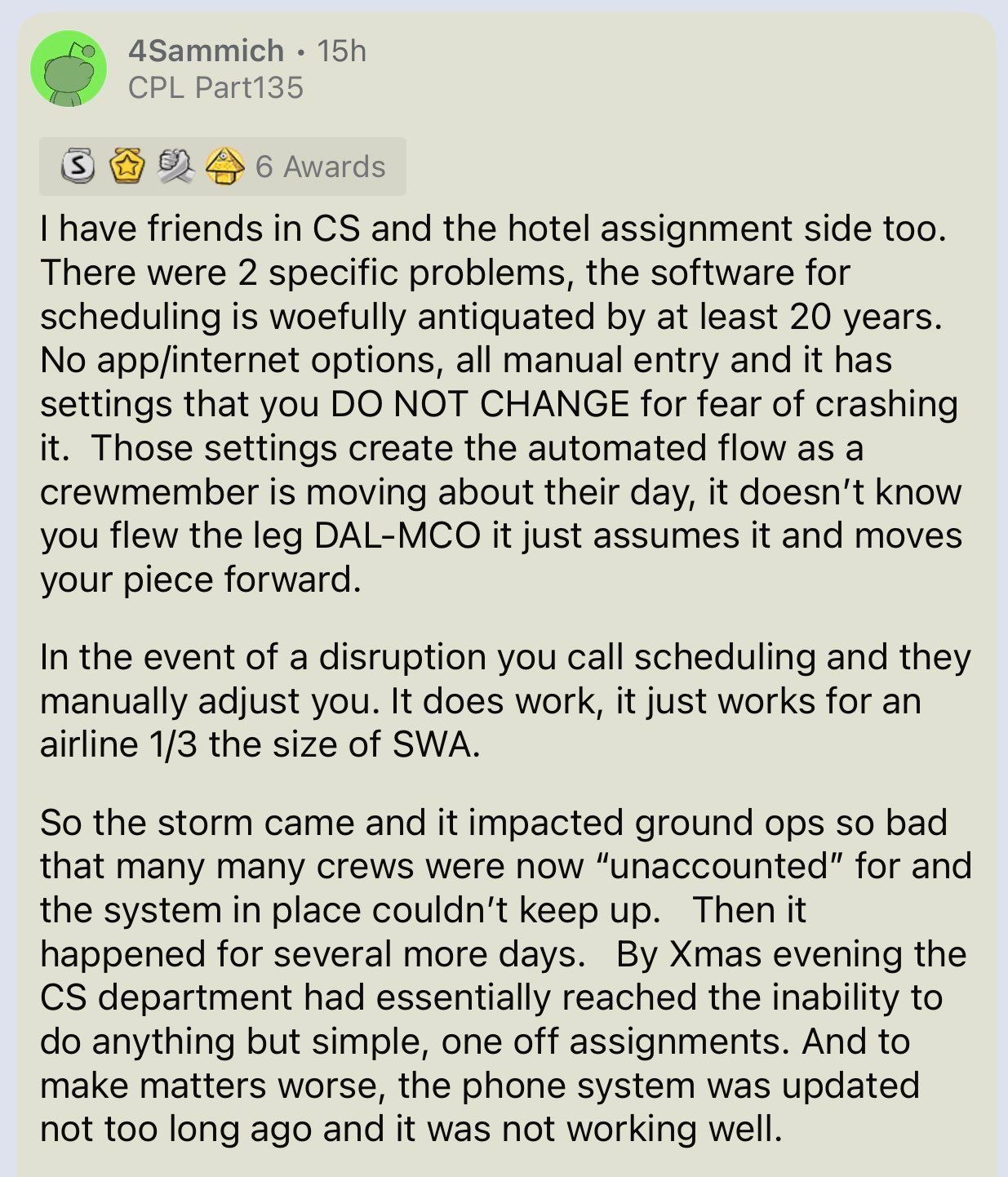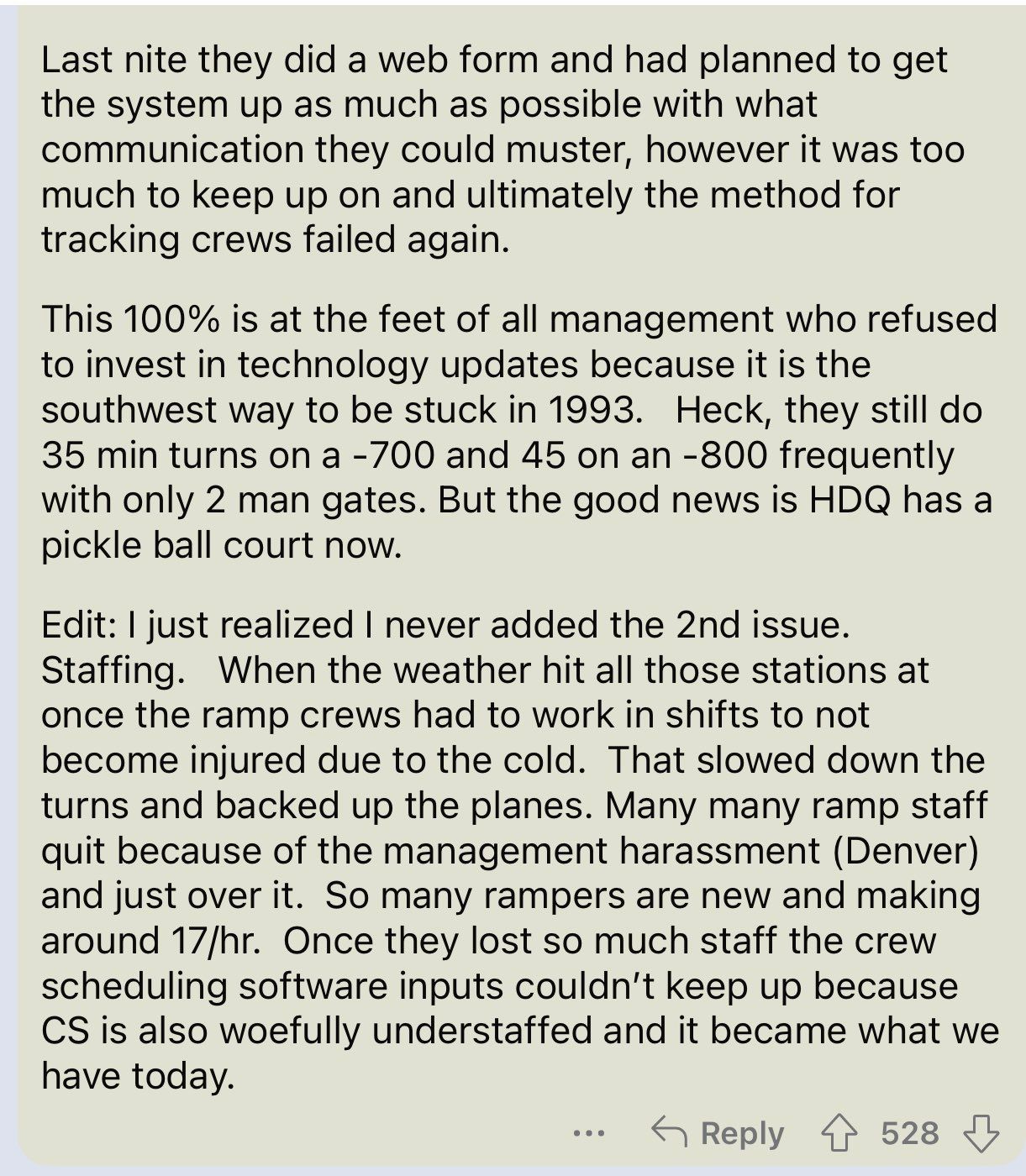The Southwest Airlines meltdown
-
Point-to-point method leads to meltdown
Unlike its rivals, which operate with a “hub-and-spoke” model, Southwest prides itself with a “point-to-point” business strategy that allows passengers to travel directly between smaller markets.
“We don’t have the normal hub like the other major airlines do,” Capt. Mike Santoro, vice president of the Southwest Airlines Pilots Association, told CNN Tuesday. “We fly a point-to-point network, which can put our crews in the wrong places, without airplanes.”
United, American and Delta typically fly from smaller markets to hubs, requiring passengers flying between small cities to change planes. But that model has the operational advantage of quickly flying crews and planes out of the hub to where they’re needed.
Southwest’s “point-to-point” model involves planes flying consecutive routes and picking up crews at those locations.
“When they have cancellations in one area, it really ripples through, because they don’t necessarily have their crews and their pilots in the right positions,” said Jeff Windau, senior equity analyst of equity research for Edward Jones. “They just kind of build on from city to city to city, and when that gets disrupted, it’s very difficult to get the operations flowing smoothly again.”
Santoro said Southwest’s meltdown was the worst disruption he’d experienced in 16 years at the airline.
Southwest’s outdated scheduling software couldn’t keep up with the constant changes, and quickly became the main culprit of the cancellations once the storm cleared, according to a transcript of a call Southwest Chief Operating Officer Andrew Watterson conducted with employees that was obtained by CNN from an aviation source.
Watterson explained that Southwest’s crew schedulers worked furiously to put a new schedule together, matching available crew with aircraft that were ready to fly. But the Federal Aviation Administration strictly regulates when flight crews can work, complicating Southwest’s scheduling efforts.
“The process of matching up those crew members with the aircraft could not be handled by our technology,” Watterson said.
Southwest ended up with planes that were ready to take off with available crew, but the company’s scheduling software wasn’t able to match them quickly and accurately, Watterson added.
“As a result, we had to ask our crew schedulers to do this manually, and it’s extraordinarily difficult,” he said. “That is a tedious, long process.”
Watterson noted that manual scheduling left Southwest building an incredibly delicate house of cards that could quickly tumble when the company encountered a problem.
-
Point-to-point method leads to meltdown
Unlike its rivals, which operate with a “hub-and-spoke” model, Southwest prides itself with a “point-to-point” business strategy that allows passengers to travel directly between smaller markets.
“We don’t have the normal hub like the other major airlines do,” Capt. Mike Santoro, vice president of the Southwest Airlines Pilots Association, told CNN Tuesday. “We fly a point-to-point network, which can put our crews in the wrong places, without airplanes.”
United, American and Delta typically fly from smaller markets to hubs, requiring passengers flying between small cities to change planes. But that model has the operational advantage of quickly flying crews and planes out of the hub to where they’re needed.
Southwest’s “point-to-point” model involves planes flying consecutive routes and picking up crews at those locations.
“When they have cancellations in one area, it really ripples through, because they don’t necessarily have their crews and their pilots in the right positions,” said Jeff Windau, senior equity analyst of equity research for Edward Jones. “They just kind of build on from city to city to city, and when that gets disrupted, it’s very difficult to get the operations flowing smoothly again.”
Santoro said Southwest’s meltdown was the worst disruption he’d experienced in 16 years at the airline.
Southwest’s outdated scheduling software couldn’t keep up with the constant changes, and quickly became the main culprit of the cancellations once the storm cleared, according to a transcript of a call Southwest Chief Operating Officer Andrew Watterson conducted with employees that was obtained by CNN from an aviation source.
Watterson explained that Southwest’s crew schedulers worked furiously to put a new schedule together, matching available crew with aircraft that were ready to fly. But the Federal Aviation Administration strictly regulates when flight crews can work, complicating Southwest’s scheduling efforts.
“The process of matching up those crew members with the aircraft could not be handled by our technology,” Watterson said.
Southwest ended up with planes that were ready to take off with available crew, but the company’s scheduling software wasn’t able to match them quickly and accurately, Watterson added.
“As a result, we had to ask our crew schedulers to do this manually, and it’s extraordinarily difficult,” he said. “That is a tedious, long process.”
Watterson noted that manual scheduling left Southwest building an incredibly delicate house of cards that could quickly tumble when the company encountered a problem.
@George-K said in The Southwest Airlines meltdown:
“As a result, we had to ask our crew schedulers to do this manually, and it’s extraordinarily difficult,” he said. “That is a tedious, long process.”
Give me a few months and I could automate the whole thing. It would be flawless and update everything in real time, instantly.
Too bad for them I am now committed to golf and the garden and other fun stuff.
-
@Axtremus said in The Southwest Airlines meltdown:
@Copper said in The Southwest Airlines meltdown:
The airlines have hated passengers for years.
Is there a major domestic airline that people like (or at least hate less)?
We are fans of Delta.
@89th said in The Southwest Airlines meltdown:
@Axtremus said in The Southwest Airlines meltdown:
@Copper said in The Southwest Airlines meltdown:
The airlines have hated passengers for years.
Is there a major domestic airline that people like (or at least hate less)?
We are fans of Delta.
I am fan of United. But I have been Global Service with them, so they treat me very well.
-
Three quarters of a billion dollars.
-
-
@Copper said in The Southwest Airlines meltdown:
idiots
Wonder what a information system would have cost?
I'm guessing a little bit less than what they lost.
@Jolly said in The Southwest Airlines meltdown:
@Copper said in The Southwest Airlines meltdown:
idiots
Wonder what a information system would have cost?
I'm guessing a little bit less than what they lost.
Jeez, yeah even 10% of that loss would've covered t3h best system ev4h.
-
Don't bet on it. These systems are incredibly complex and delicate, as we have seen. To begin such an endeavor is potential career suicide for execs, with a low probability of full success within one's tenure. There is a high probability of huge cost overruns and delays.
-
@Copper said in The Southwest Airlines meltdown:
idiots
Wonder what a information system would have cost?
I'm guessing a little bit less than what they lost.
@Jolly said in The Southwest Airlines meltdown:
@Copper said in The Southwest Airlines meltdown:
idiots
Wonder what a information system would have cost?
I'm guessing a little bit less than what they lost.
Excellent point.
-
Don't bet on it. These systems are incredibly complex and delicate, as we have seen. To begin such an endeavor is potential career suicide for execs, with a low probability of full success within one's tenure. There is a high probability of huge cost overruns and delays.
@Mik said in The Southwest Airlines meltdown:
Don't bet on it. These systems are incredibly complex and delicate, as we have seen. To begin such an endeavor is potential career suicide for execs, with a low probability of full success within one's tenure. There is a high probability of huge cost overruns and delays.
Yeah but if you gave $80 million to Horace, he would have the IT system done in a few weeks. He would even post timelapse photos of it as it's being built.
-
@Mik said in The Southwest Airlines meltdown:
Don't bet on it. These systems are incredibly complex and delicate, as we have seen. To begin such an endeavor is potential career suicide for execs, with a low probability of full success within one's tenure. There is a high probability of huge cost overruns and delays.
Yeah but if you gave $80 million to Horace, he would have the IT system done in a few weeks. He would even post timelapse photos of it as it's being built.
@89th said in The Southwest Airlines meltdown:
@Mik said in The Southwest Airlines meltdown:
Don't bet on it. These systems are incredibly complex and delicate, as we have seen. To begin such an endeavor is potential career suicide for execs, with a low probability of full success within one's tenure. There is a high probability of huge cost overruns and delays.
Yeah but if you gave $80 million to Horace, he would have the IT system done in a few weeks. He would even post timelapse photos of it as it's being built.
Not just me. Mark or Copper could do it even better.
-
I don't know what sort of systems Copper has worked on, but Mark’s software probably has more in common, tracking and sharing equipment location, usage and maintenance. He would have a good idea of the immensity of adding passengers, crews, flight times, luggage, etc. to that.
-
Only flew SW once. It was nice back then, late 90's. I'd have a very hard time buying a ticket from them now.

